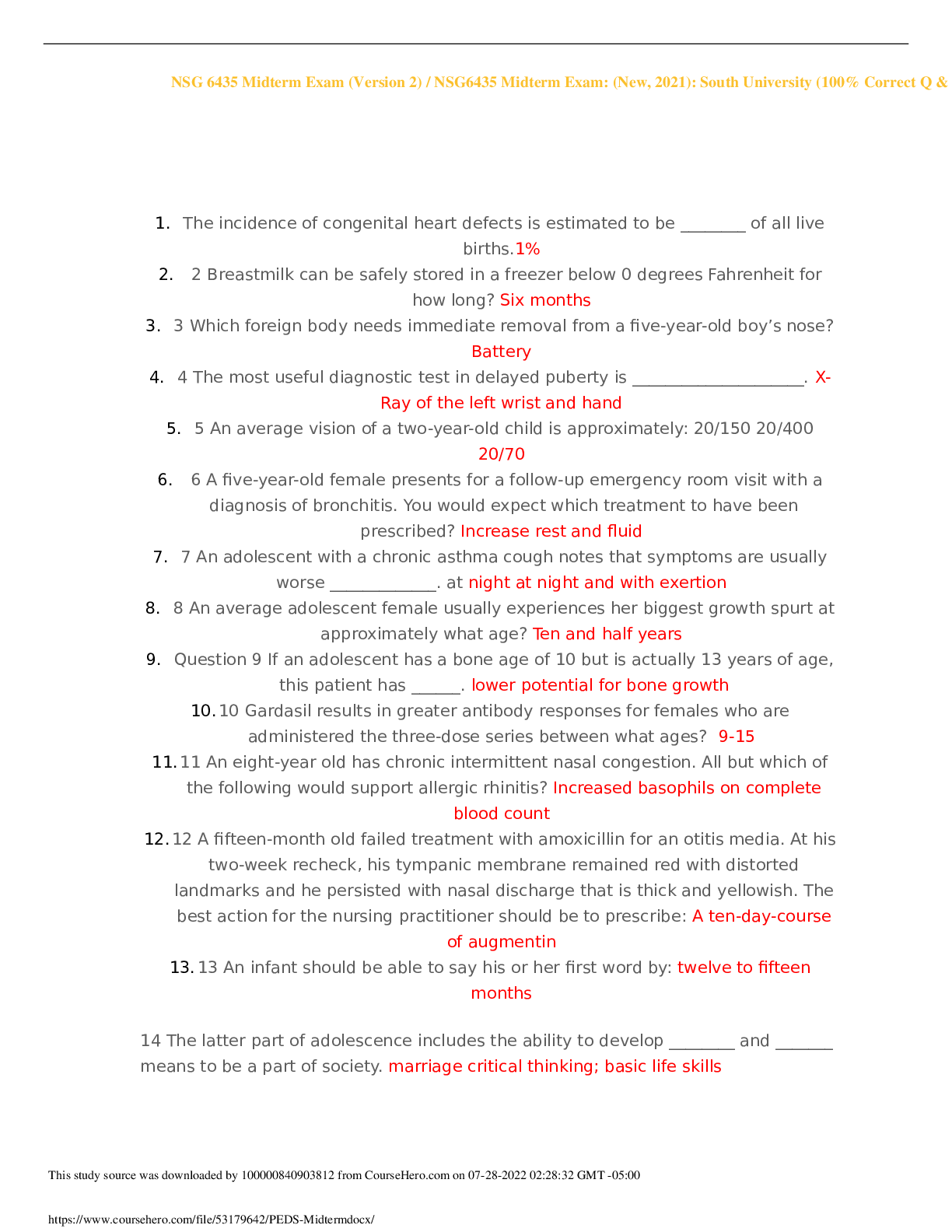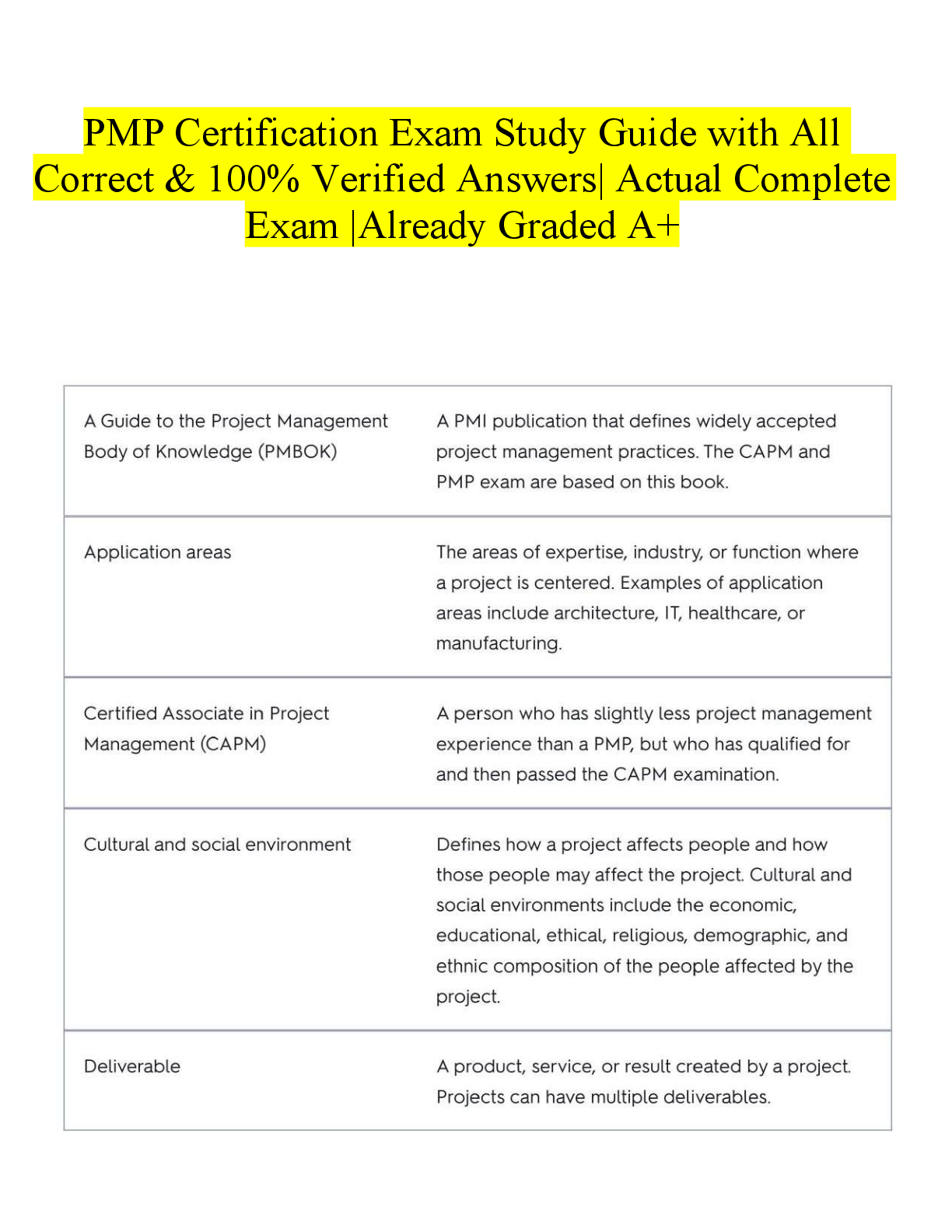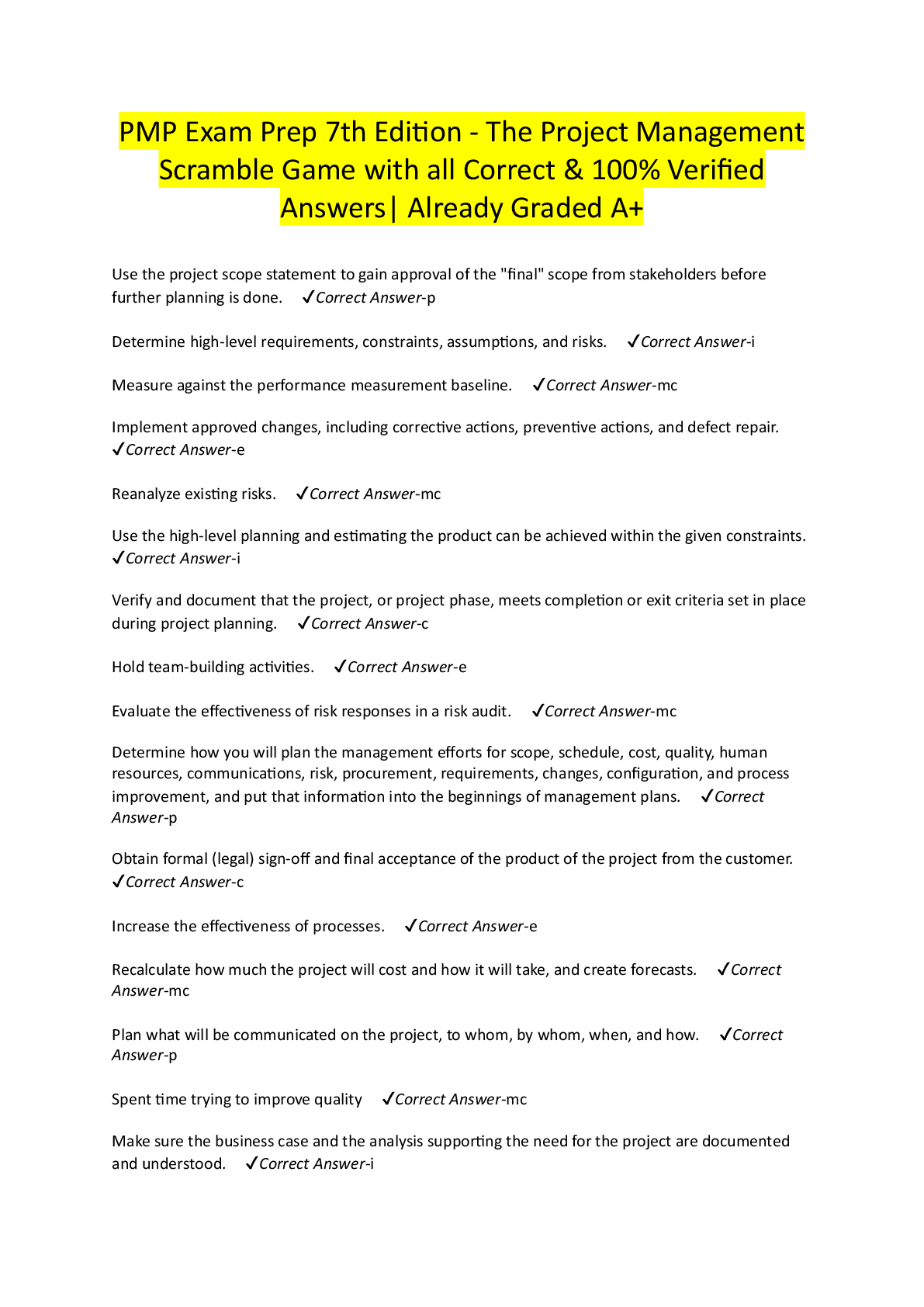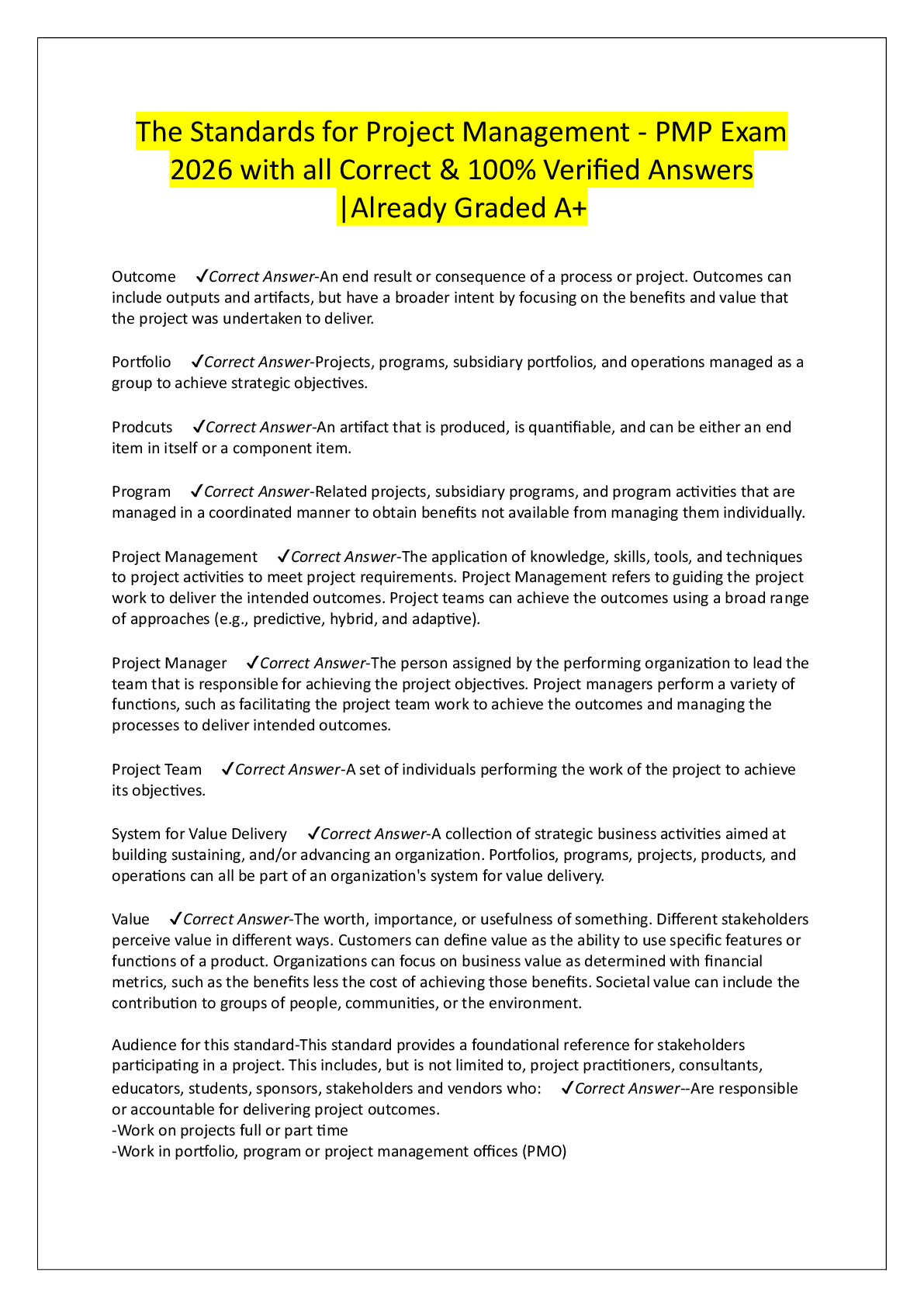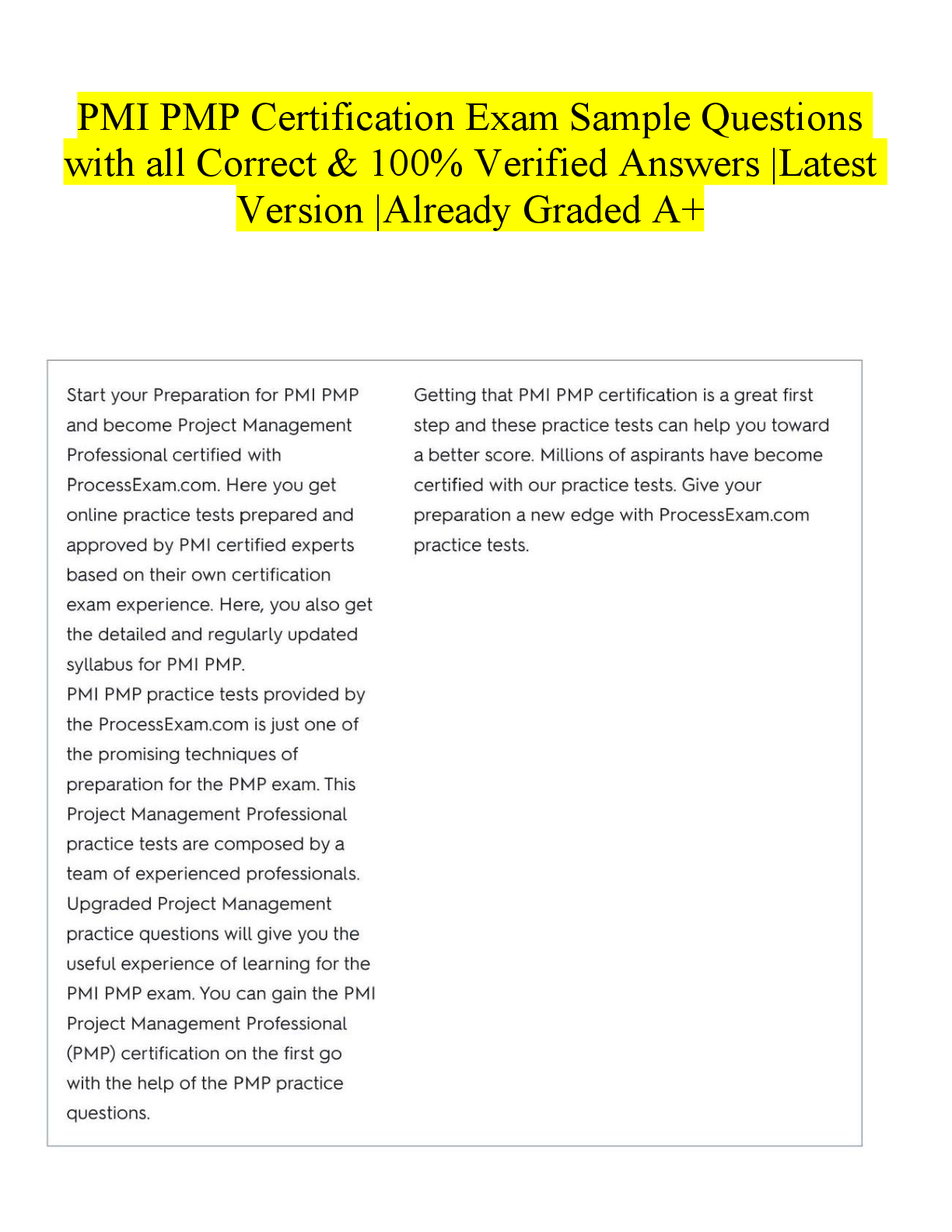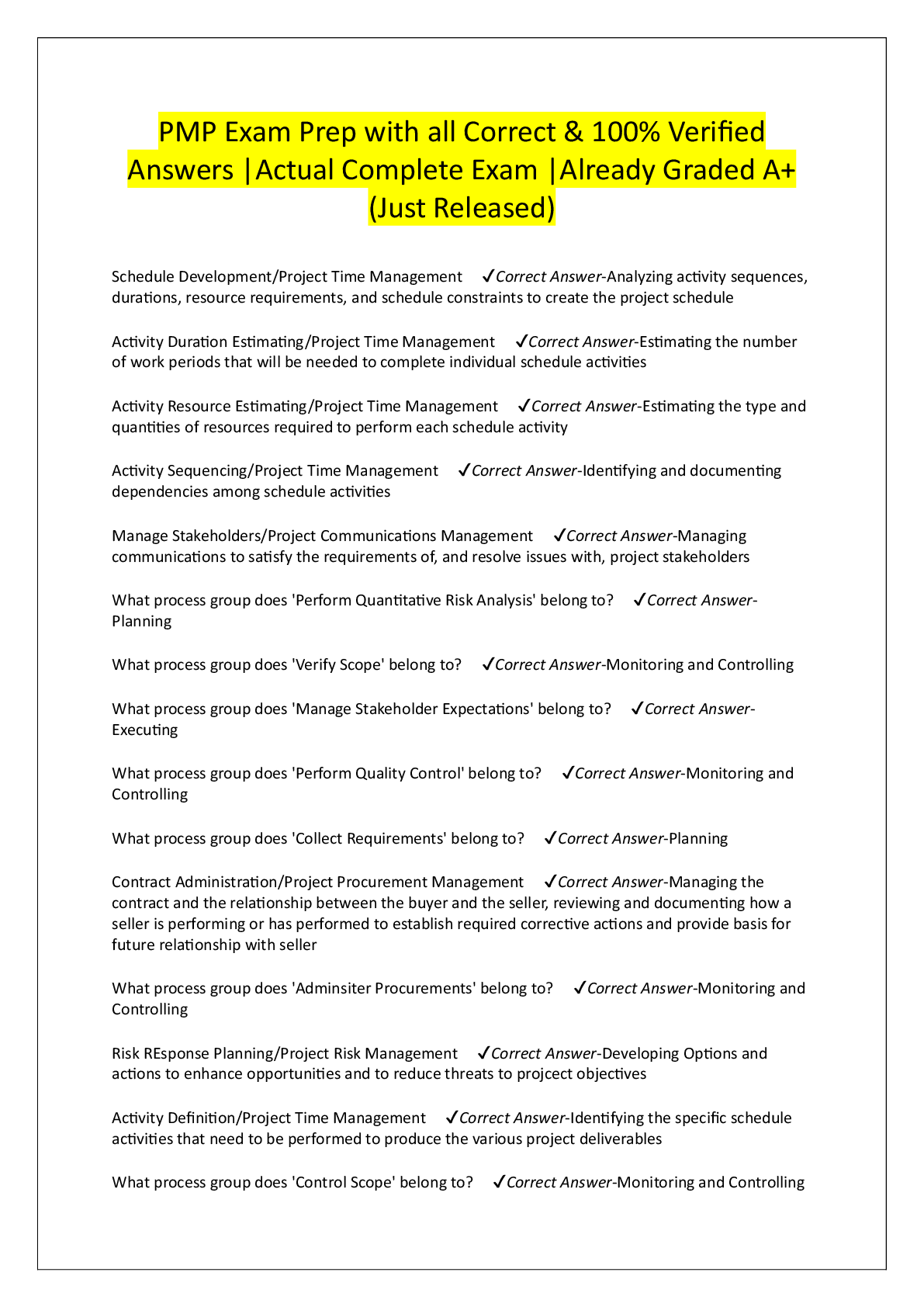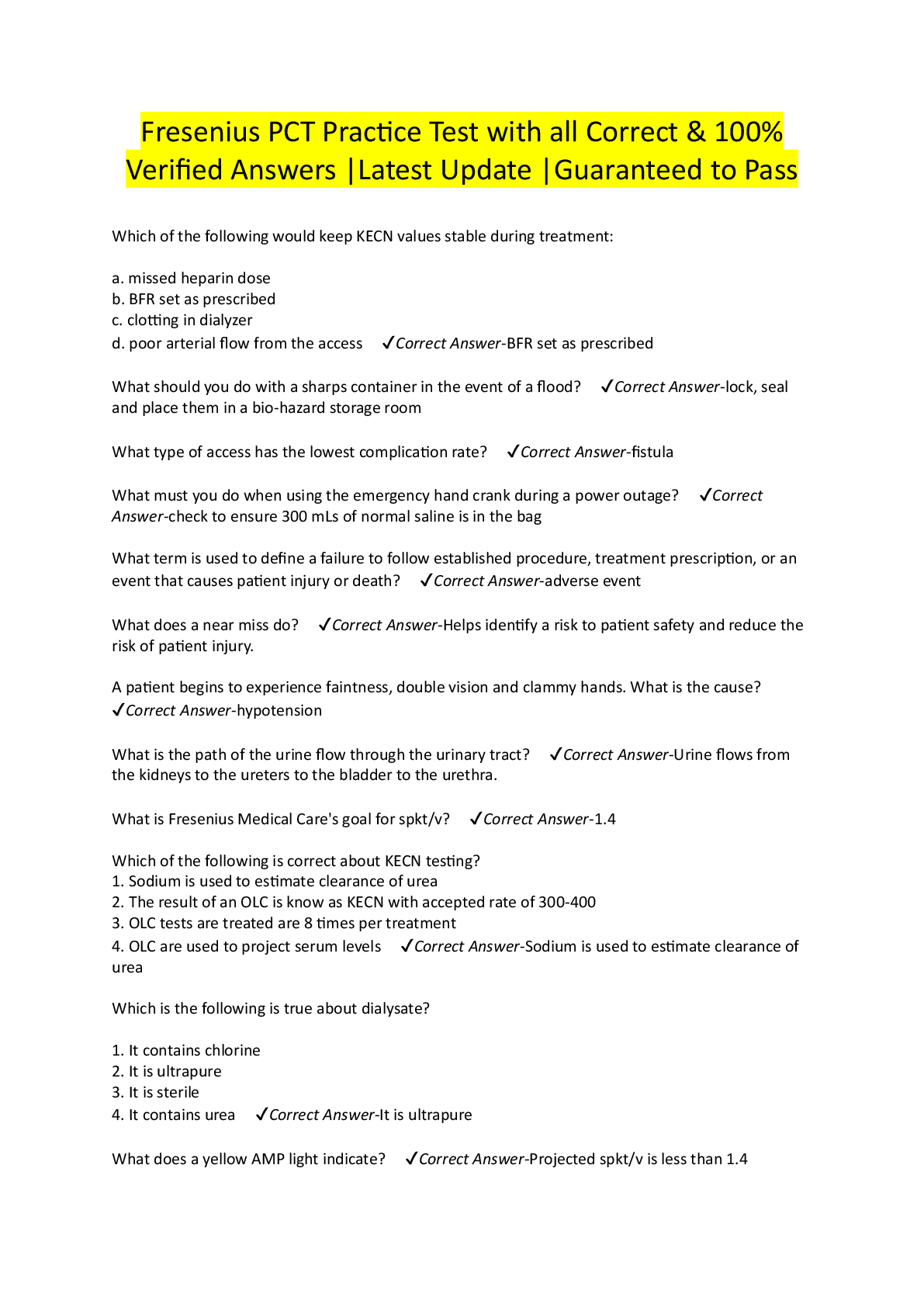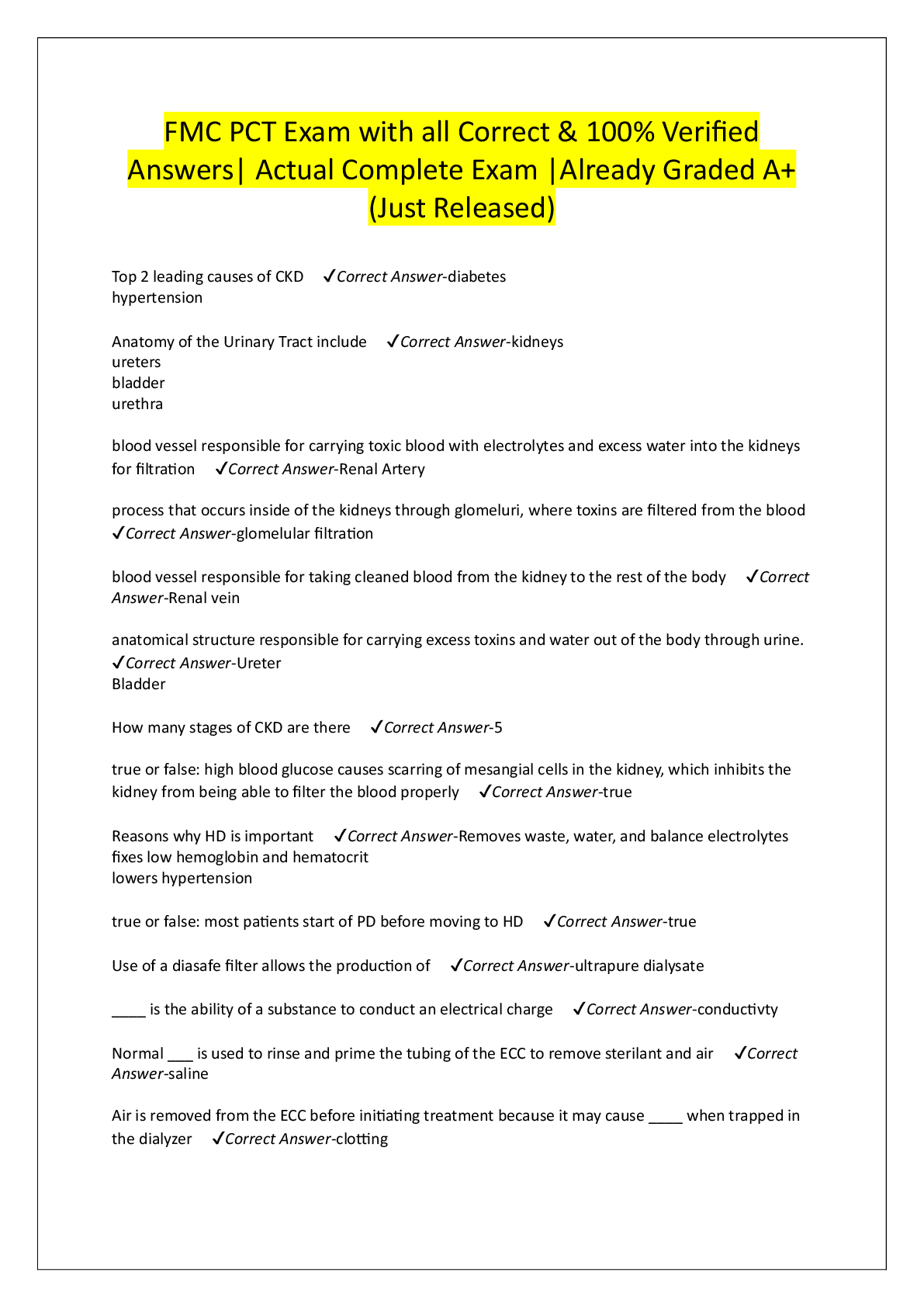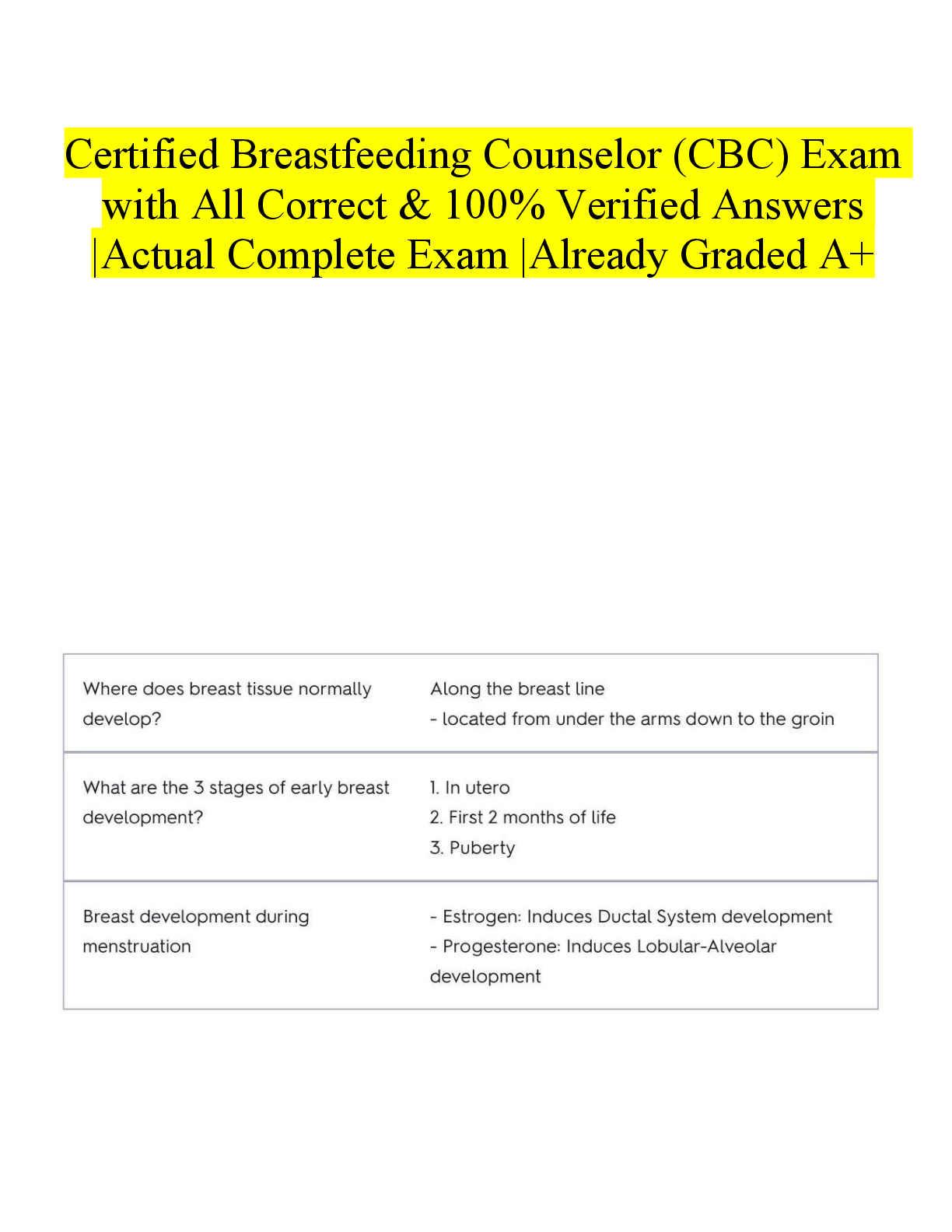Health Care > EXAM > NURS-202 F&E, Shock, Burns, Immune 2022 EXAM QUESTIONS AND ANSWERS| GRADED A (All)
NURS-202 F&E, Shock, Burns, Immune 2022 EXAM QUESTIONS AND ANSWERS| GRADED A
Document Content and Description Below
NURS-202 F&E, Shock, Burns, Immune 2022 what is the blood volume of an average adult? what percentage of that is plasma? Correct Answer: 6 L - approx 60% of their body weight 50% is plasma ... what is the average intake/output that a body processes in a day? Correct Answer: 2500 mL what is normal serum osmolality? Correct Answer: 275-295 high is dry how does osmolality affect fluid movement? Correct Answer: hypotonic fluid has little solutes, intracellular has a lot fluid tries to balance concentration moves into cells cell swells hypertonic fluid has lots of solutes, intracellular few fluid tries to balance concentration moves out of cells cell shrinks isotonic fluid and intracellular space are balanced cell remains the same we typically use _____tonic fluids for fluid replacement Correct Answer: isotonic indications for using hypertonic vs hypotonic fluids Correct Answer: hypertonic severe dehydration severe electrolyte imbalance severe hyponatremia hypotonic dehydration hypotonic DKA hyperosmolar hyperglycemia hypertonic dehydration what is the difference between osmolarity and osmolality? Correct Answer: osmolarity measures solutes in a liter (by volume) such as in a bag of fluid osmolality measures solutes in a kilogram (by weight) such as in your body which body systems help to regulate fluid and electrolyte balance? Correct Answer: renal system kidneys are primary organ to regulate endocrine system RAAS ADH natriuretic peptides respiratory system breathing out humidity can hypo/hyper ventilate as needed what are insensible losses? Correct Answer: fluid lost that isn't easily measured Examples: skin - sweat lungs - humidity of breath stool - diarrhea hypermetabolic state - fluid shifts (trauma, burns, fever, thyroid crisis) what is the difference between first, second and third spacing? Correct Answer: first spacing normal distribution of fluid second spacing abnormal accumulation in interstitial spaces third spacing fluid shift from intravascular to interstitial fluid is unavailable for use in the body can lead to hypovolemia Example: ascites what is anasarca? Correct Answer: generalized edema - swelling of the whole body how can cirhossis cause ascites? Correct Answer: vessels around the liver become permeable, fluid leaks from vessels into the interstitium and accumulates in the abdominal cavity causes of hypovolemia? what are some assessment questions? Correct Answer: fluid losses GI perspiration hemorrhage diabetes insipidus DKA adrenal insufficiency fluid shifts/3rd spacing fluid volume deficiency inadequate intake how many times vomited/diarrhea in last 24 hours? are you able to keep any fluids down? child: how many wet diapers? child: if diarrhea, can you tell if urine in diaper also? hypovolemia s/sx Correct Answer: loss of turgor concentrated urine output high urine specific gravity oliguria high BUN thirst dry mucous membranes weak and thready pulses flattened neck veins hypotension tachycardia anxiety restlessness poor skin signs (cool, pale, sweaty) managing hypovolemia Correct Answer: monitor labs CMP (BUN high, creatinine usually normal) CBC (high) serum osmol (high) urine osmol (high) urine specific gravity (high) replace fluids identify problem oral fluids IV isotonic fluids for volume loss IV blood for trauma/blood loss monitor I&O monitor s/sx shock think decreased perfusion The nurse assesses for which clinical manifestations in the patient with dehydration? A. increased urine specific gravity B. increased serum BUN C. increased serum osmolality D. decreased serum osmolality Correct Answer: A, B, C causes of hypervolemia Correct Answer: sodium and water retention cirrhosis heart failure adrenal gland disorders use of corticosteroids s/sx hypervolemia Correct Answer: weight gain ascites edema, pitting edema 2nd/3rd spacing increased urine output hypertension tachycardia JVD orthopnea altered cap refill management of hypervolemia Correct Answer: labs serum electrolytes hematocrit (dilute) BUN (dilute) serum osmol (low) albumin (dilute) evaluate cause limit fluid intake limit sodium intake treat manifestations monitor for worsening s/sx pulmonary edema monitor weight 1L of water = 1 kg (2.2lb) how much does 1 liter of water weigh? Correct Answer: 1 kg / 2.2 lb what are the basic reasons for fluid and electrolyte imbalances? Correct Answer: directly caused by illnesses result of therapeutic measures (IE diuretics, medications, fluid resuscitation) what are the normal ranges for the following labs: serum sodium serum chloride serum potassium total serum calcium ionized calcium serum osmolality Correct Answer: serum sodium 135 - 145 serum chloride 97 - 107 serum potassium 3.5 - 5 total serum calcium 8.2 - 10.2 ionized calcium 4.6 - 5.3 serum osmolality 275 - 295 what is the most common electrolyte disorder? Correct Answer: hyponatremia clinical manifestations of hyponatremia **need to know per lecture** lecture and p122-123 Correct Answer: lethargy headache muscle cramps confusion nausea/vomiting seizures coma dependent on severity, speed of onset (very severe hyponatremia or rapid depletion of sodium can lead to permanent brain damage or death) management for hyponatremia **need to know per lecture** lecture and p122-123 Correct Answer: replacement of sodium (PO, IV, enteral) patient education (salty foods) fluid restriction loop diuretics slow replacement is important! too fast can cause cerebral edema, coma, brain death hypovolemic hyponatremia 0.9% NS IV fluids euvolemic hyponatremia water restriction 1 L or less daily hypervolemic hyponatremia hypertonic solutions if neuro sx present (3% saline) what is important to remember (safety) about electrolyte replacement? Correct Answer: most are IV piggyback, slow drip with a pump! NEVER IV PUSH especially sodium and potassium clinical manifestations of hypernatremia **need to know per lecture** lecture and p122-123 Correct Answer: thirst s/sx dehydration agitation restlessness lethargy coma seizures neuromuscular irritability confusion tachycardia dry mucous membranes flushed skin hallucinations, delusions, disorientation if severe management for hypernatremia **need to know per lecture** lecture and p122-123 Correct Answer: limiting sodium intake close monitoring of I&O (very closely if brain injury) endure adequate water intake teach about low and high sodium foods replacing water deficits hypotonic fluids (0.045% NaCl, D5W) slow replacement! cerebral edema if too fast! sodium and what other electrolyte rise and fall together? Correct Answer: sodium and chloride causes of hypochloremia lecture and p122-123 Correct Answer: severe vomiting burns chronic respiratory acidosis NG suction metabolic alkalosis Addison's disease clinical manifestations of hypochloremia **need to know per lecture** lecture and p122-123 Correct Answer: irritability hypotension tetany shallow respirations hyperexcitability of muscles and nerves cardiac dysrythmias management for hypochloremia **need to know per lecture** lecture and p122-123 Correct Answer: treat cause replace chloride 0.45% NS correct metabolic alkalosis recognize assess patient education monitor labs sodium chloride clinical manifestations of hyperchloremia **need to know per lecture** lecture and p122-123 Correct Answer: metabolic acidosis tachypnea (deep, rapid respirations) tachycardia lethargy decreased cognitive ability hypertension [Show More]
Last updated: 3 years ago
Preview 1 out of 72 pages

Buy this document to get the full access instantly
Instant Download Access after purchase
Buy NowInstant download
We Accept:

Reviews( 0 )
$18.00
Can't find what you want? Try our AI powered Search
Document information
Connected school, study & course
About the document
Uploaded On
Jun 23, 2022
Number of pages
72
Written in
All
Additional information
This document has been written for:
Uploaded
Jun 23, 2022
Downloads
0
Views
92






.png)




